Report on Structural Member Behavior, Bond, and Flexural Analysis
VerifiedAdded on 2020/03/04
|22
|9906
|432
Report
AI Summary
This report comprehensively analyzes the structural behavior of building components, focusing on the interaction between structural members, bond behavior, and flexural characteristics. It begins by categorizing structural members and explaining their behavior under various stresses, including tension, compression, bending, shear, and buckling. The report then delves into bond and flexural behavior, emphasizing the importance of the bond between steel and concrete for structural integrity, including development length and bond stress. It examines bond behavior at structural, member, and material levels, highlighting factors that affect bond strength such as rebar spacing, placement, and concrete cover. Furthermore, the report discusses the impact of bond deterioration on overall structural behavior, particularly under dynamic loading, and the effects of concrete aging. Finally, the report explores the flexural behavior of steel bar reinforcement and concrete, defining flexural strength and analyzing the factors influencing flexural behavior in reinforced concrete structures. The report concludes by emphasizing the critical role of the bond between concrete and steel for structural performance and safety, including how the bond is affected by corrosion and other factors.
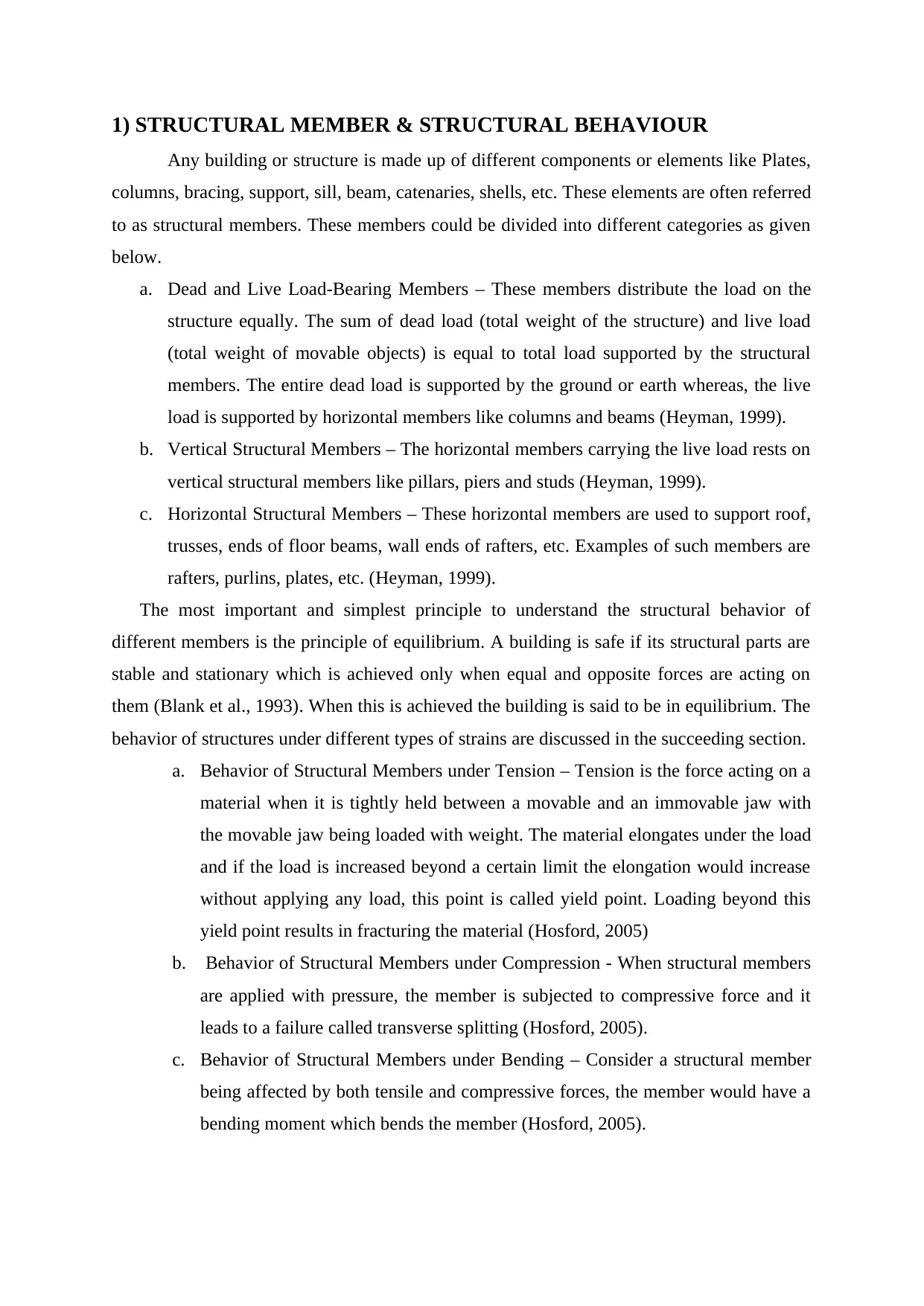
1) STRUCTURAL MEMBER & STRUCTURAL BEHAVIOUR
Any building or structure is made up of different components or elements like Plates,
columns, bracing, support, sill, beam, catenaries, shells, etc. These elements are often referred
to as structural members. These members could be divided into different categories as given
below.
a. Dead and Live Load-Bearing Members – These members distribute the load on the
structure equally. The sum of dead load (total weight of the structure) and live load
(total weight of movable objects) is equal to total load supported by the structural
members. The entire dead load is supported by the ground or earth whereas, the live
load is supported by horizontal members like columns and beams (Heyman, 1999).
b. Vertical Structural Members – The horizontal members carrying the live load rests on
vertical structural members like pillars, piers and studs (Heyman, 1999).
c. Horizontal Structural Members – These horizontal members are used to support roof,
trusses, ends of floor beams, wall ends of rafters, etc. Examples of such members are
rafters, purlins, plates, etc. (Heyman, 1999).
The most important and simplest principle to understand the structural behavior of
different members is the principle of equilibrium. A building is safe if its structural parts are
stable and stationary which is achieved only when equal and opposite forces are acting on
them (Blank et al., 1993). When this is achieved the building is said to be in equilibrium. The
behavior of structures under different types of strains are discussed in the succeeding section.
a. Behavior of Structural Members under Tension – Tension is the force acting on a
material when it is tightly held between a movable and an immovable jaw with
the movable jaw being loaded with weight. The material elongates under the load
and if the load is increased beyond a certain limit the elongation would increase
without applying any load, this point is called yield point. Loading beyond this
yield point results in fracturing the material (Hosford, 2005)
b. Behavior of Structural Members under Compression - When structural members
are applied with pressure, the member is subjected to compressive force and it
leads to a failure called transverse splitting (Hosford, 2005).
c. Behavior of Structural Members under Bending – Consider a structural member
being affected by both tensile and compressive forces, the member would have a
bending moment which bends the member (Hosford, 2005).
Any building or structure is made up of different components or elements like Plates,
columns, bracing, support, sill, beam, catenaries, shells, etc. These elements are often referred
to as structural members. These members could be divided into different categories as given
below.
a. Dead and Live Load-Bearing Members – These members distribute the load on the
structure equally. The sum of dead load (total weight of the structure) and live load
(total weight of movable objects) is equal to total load supported by the structural
members. The entire dead load is supported by the ground or earth whereas, the live
load is supported by horizontal members like columns and beams (Heyman, 1999).
b. Vertical Structural Members – The horizontal members carrying the live load rests on
vertical structural members like pillars, piers and studs (Heyman, 1999).
c. Horizontal Structural Members – These horizontal members are used to support roof,
trusses, ends of floor beams, wall ends of rafters, etc. Examples of such members are
rafters, purlins, plates, etc. (Heyman, 1999).
The most important and simplest principle to understand the structural behavior of
different members is the principle of equilibrium. A building is safe if its structural parts are
stable and stationary which is achieved only when equal and opposite forces are acting on
them (Blank et al., 1993). When this is achieved the building is said to be in equilibrium. The
behavior of structures under different types of strains are discussed in the succeeding section.
a. Behavior of Structural Members under Tension – Tension is the force acting on a
material when it is tightly held between a movable and an immovable jaw with
the movable jaw being loaded with weight. The material elongates under the load
and if the load is increased beyond a certain limit the elongation would increase
without applying any load, this point is called yield point. Loading beyond this
yield point results in fracturing the material (Hosford, 2005)
b. Behavior of Structural Members under Compression - When structural members
are applied with pressure, the member is subjected to compressive force and it
leads to a failure called transverse splitting (Hosford, 2005).
c. Behavior of Structural Members under Bending – Consider a structural member
being affected by both tensile and compressive forces, the member would have a
bending moment which bends the member (Hosford, 2005).
Paraphrase This Document
Need a fresh take? Get an instant paraphrase of this document with our AI Paraphraser
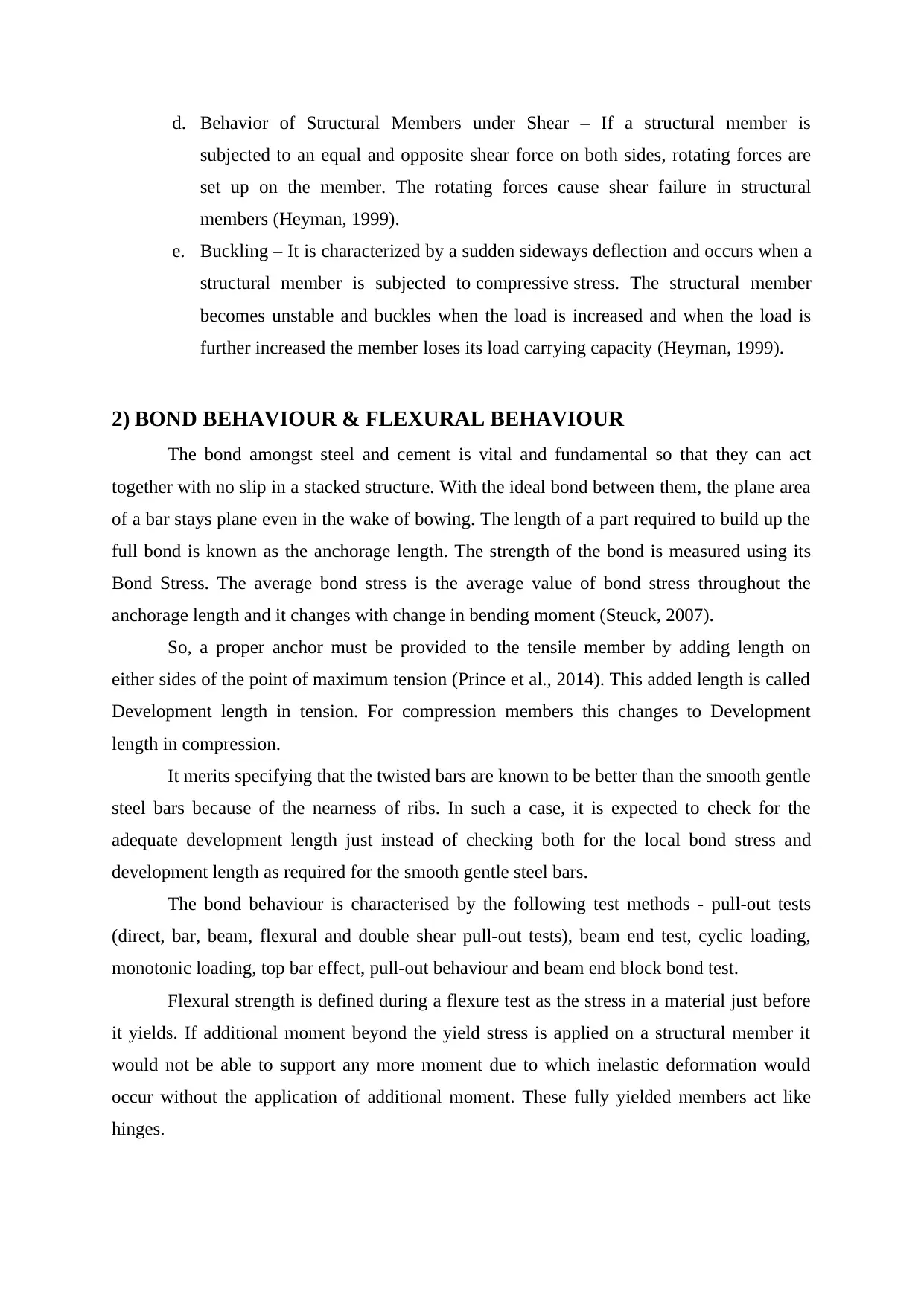
d. Behavior of Structural Members under Shear – If a structural member is
subjected to an equal and opposite shear force on both sides, rotating forces are
set up on the member. The rotating forces cause shear failure in structural
members (Heyman, 1999).
e. Buckling – It is characterized by a sudden sideways deflection and occurs when a
structural member is subjected to compressive stress. The structural member
becomes unstable and buckles when the load is increased and when the load is
further increased the member loses its load carrying capacity (Heyman, 1999).
2) BOND BEHAVIOUR & FLEXURAL BEHAVIOUR
The bond amongst steel and cement is vital and fundamental so that they can act
together with no slip in a stacked structure. With the ideal bond between them, the plane area
of a bar stays plane even in the wake of bowing. The length of a part required to build up the
full bond is known as the anchorage length. The strength of the bond is measured using its
Bond Stress. The average bond stress is the average value of bond stress throughout the
anchorage length and it changes with change in bending moment (Steuck, 2007).
So, a proper anchor must be provided to the tensile member by adding length on
either sides of the point of maximum tension (Prince et al., 2014). This added length is called
Development length in tension. For compression members this changes to Development
length in compression.
It merits specifying that the twisted bars are known to be better than the smooth gentle
steel bars because of the nearness of ribs. In such a case, it is expected to check for the
adequate development length just instead of checking both for the local bond stress and
development length as required for the smooth gentle steel bars.
The bond behaviour is characterised by the following test methods - pull-out tests
(direct, bar, beam, flexural and double shear pull-out tests), beam end test, cyclic loading,
monotonic loading, top bar effect, pull-out behaviour and beam end block bond test.
Flexural strength is defined during a flexure test as the stress in a material just before
it yields. If additional moment beyond the yield stress is applied on a structural member it
would not be able to support any more moment due to which inelastic deformation would
occur without the application of additional moment. These fully yielded members act like
hinges.
subjected to an equal and opposite shear force on both sides, rotating forces are
set up on the member. The rotating forces cause shear failure in structural
members (Heyman, 1999).
e. Buckling – It is characterized by a sudden sideways deflection and occurs when a
structural member is subjected to compressive stress. The structural member
becomes unstable and buckles when the load is increased and when the load is
further increased the member loses its load carrying capacity (Heyman, 1999).
2) BOND BEHAVIOUR & FLEXURAL BEHAVIOUR
The bond amongst steel and cement is vital and fundamental so that they can act
together with no slip in a stacked structure. With the ideal bond between them, the plane area
of a bar stays plane even in the wake of bowing. The length of a part required to build up the
full bond is known as the anchorage length. The strength of the bond is measured using its
Bond Stress. The average bond stress is the average value of bond stress throughout the
anchorage length and it changes with change in bending moment (Steuck, 2007).
So, a proper anchor must be provided to the tensile member by adding length on
either sides of the point of maximum tension (Prince et al., 2014). This added length is called
Development length in tension. For compression members this changes to Development
length in compression.
It merits specifying that the twisted bars are known to be better than the smooth gentle
steel bars because of the nearness of ribs. In such a case, it is expected to check for the
adequate development length just instead of checking both for the local bond stress and
development length as required for the smooth gentle steel bars.
The bond behaviour is characterised by the following test methods - pull-out tests
(direct, bar, beam, flexural and double shear pull-out tests), beam end test, cyclic loading,
monotonic loading, top bar effect, pull-out behaviour and beam end block bond test.
Flexural strength is defined during a flexure test as the stress in a material just before
it yields. If additional moment beyond the yield stress is applied on a structural member it
would not be able to support any more moment due to which inelastic deformation would
occur without the application of additional moment. These fully yielded members act like
hinges.
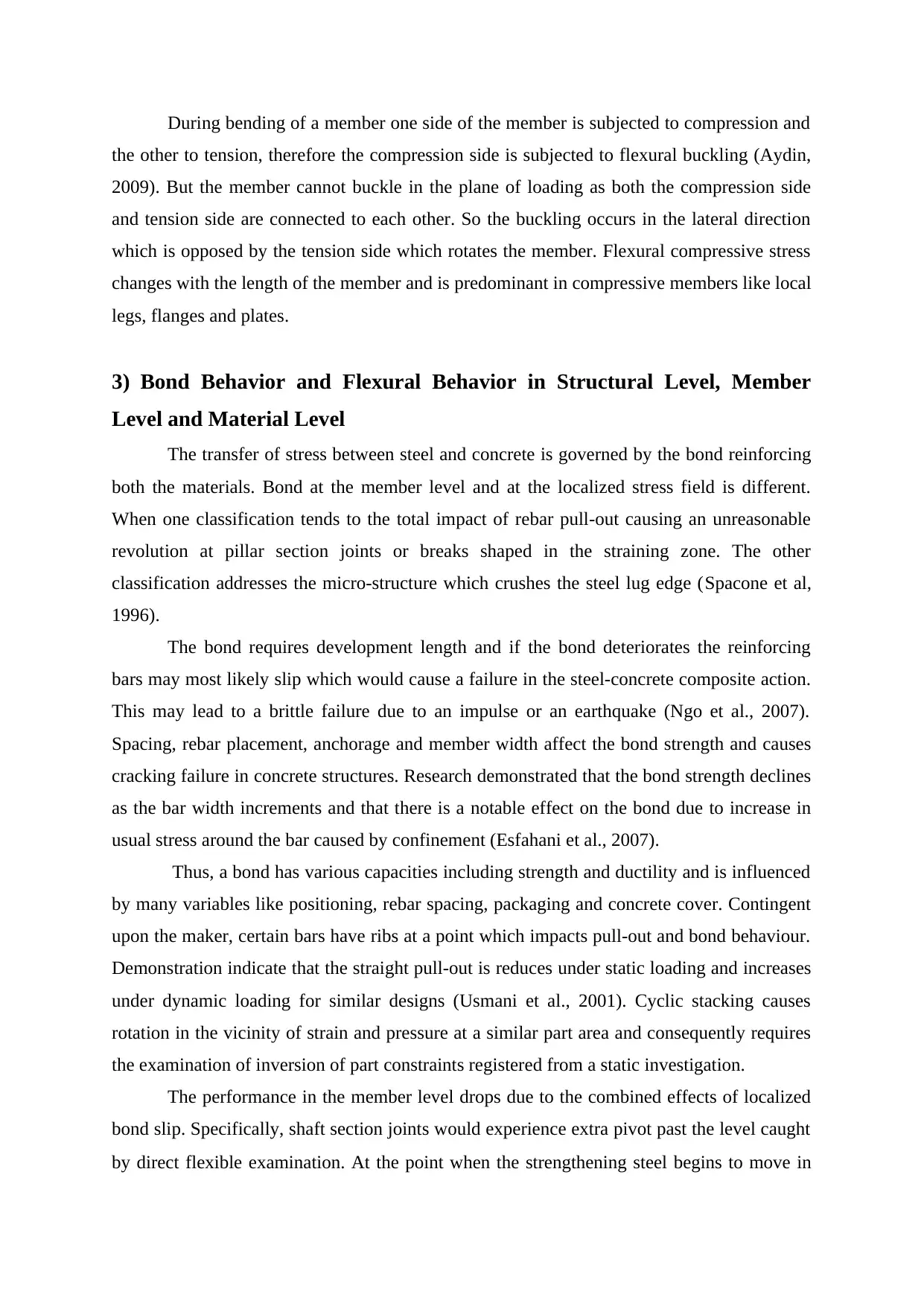
During bending of a member one side of the member is subjected to compression and
the other to tension, therefore the compression side is subjected to flexural buckling (Aydin,
2009). But the member cannot buckle in the plane of loading as both the compression side
and tension side are connected to each other. So the buckling occurs in the lateral direction
which is opposed by the tension side which rotates the member. Flexural compressive stress
changes with the length of the member and is predominant in compressive members like local
legs, flanges and plates.
3) Bond Behavior and Flexural Behavior in Structural Level, Member
Level and Material Level
The transfer of stress between steel and concrete is governed by the bond reinforcing
both the materials. Bond at the member level and at the localized stress field is different.
When one classification tends to the total impact of rebar pull-out causing an unreasonable
revolution at pillar section joints or breaks shaped in the straining zone. The other
classification addresses the micro-structure which crushes the steel lug edge (Spacone et al,
1996).
The bond requires development length and if the bond deteriorates the reinforcing
bars may most likely slip which would cause a failure in the steel-concrete composite action.
This may lead to a brittle failure due to an impulse or an earthquake (Ngo et al., 2007).
Spacing, rebar placement, anchorage and member width affect the bond strength and causes
cracking failure in concrete structures. Research demonstrated that the bond strength declines
as the bar width increments and that there is a notable effect on the bond due to increase in
usual stress around the bar caused by confinement (Esfahani et al., 2007).
Thus, a bond has various capacities including strength and ductility and is influenced
by many variables like positioning, rebar spacing, packaging and concrete cover. Contingent
upon the maker, certain bars have ribs at a point which impacts pull-out and bond behaviour.
Demonstration indicate that the straight pull-out is reduces under static loading and increases
under dynamic loading for similar designs (Usmani et al., 2001). Cyclic stacking causes
rotation in the vicinity of strain and pressure at a similar part area and consequently requires
the examination of inversion of part constraints registered from a static investigation.
The performance in the member level drops due to the combined effects of localized
bond slip. Specifically, shaft section joints would experience extra pivot past the level caught
by direct flexible examination. At the point when the strengthening steel begins to move in
the other to tension, therefore the compression side is subjected to flexural buckling (Aydin,
2009). But the member cannot buckle in the plane of loading as both the compression side
and tension side are connected to each other. So the buckling occurs in the lateral direction
which is opposed by the tension side which rotates the member. Flexural compressive stress
changes with the length of the member and is predominant in compressive members like local
legs, flanges and plates.
3) Bond Behavior and Flexural Behavior in Structural Level, Member
Level and Material Level
The transfer of stress between steel and concrete is governed by the bond reinforcing
both the materials. Bond at the member level and at the localized stress field is different.
When one classification tends to the total impact of rebar pull-out causing an unreasonable
revolution at pillar section joints or breaks shaped in the straining zone. The other
classification addresses the micro-structure which crushes the steel lug edge (Spacone et al,
1996).
The bond requires development length and if the bond deteriorates the reinforcing
bars may most likely slip which would cause a failure in the steel-concrete composite action.
This may lead to a brittle failure due to an impulse or an earthquake (Ngo et al., 2007).
Spacing, rebar placement, anchorage and member width affect the bond strength and causes
cracking failure in concrete structures. Research demonstrated that the bond strength declines
as the bar width increments and that there is a notable effect on the bond due to increase in
usual stress around the bar caused by confinement (Esfahani et al., 2007).
Thus, a bond has various capacities including strength and ductility and is influenced
by many variables like positioning, rebar spacing, packaging and concrete cover. Contingent
upon the maker, certain bars have ribs at a point which impacts pull-out and bond behaviour.
Demonstration indicate that the straight pull-out is reduces under static loading and increases
under dynamic loading for similar designs (Usmani et al., 2001). Cyclic stacking causes
rotation in the vicinity of strain and pressure at a similar part area and consequently requires
the examination of inversion of part constraints registered from a static investigation.
The performance in the member level drops due to the combined effects of localized
bond slip. Specifically, shaft section joints would experience extra pivot past the level caught
by direct flexible examination. At the point when the strengthening steel begins to move in
⊘ This is a preview!⊘
Do you want full access?
Subscribe today to unlock all pages.

Trusted by 1+ million students worldwide
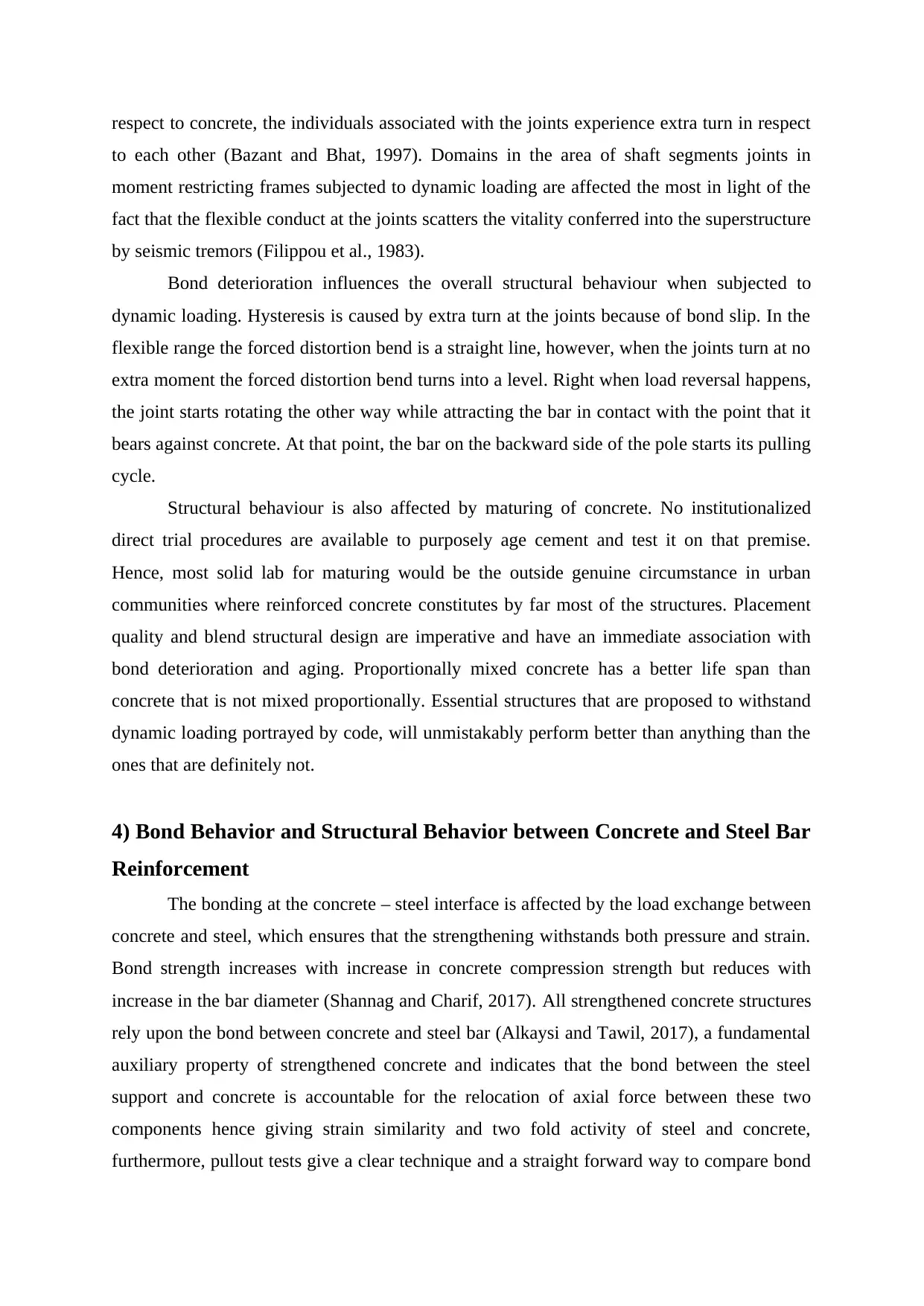
respect to concrete, the individuals associated with the joints experience extra turn in respect
to each other (Bazant and Bhat, 1997). Domains in the area of shaft segments joints in
moment restricting frames subjected to dynamic loading are affected the most in light of the
fact that the flexible conduct at the joints scatters the vitality conferred into the superstructure
by seismic tremors (Filippou et al., 1983).
Bond deterioration influences the overall structural behaviour when subjected to
dynamic loading. Hysteresis is caused by extra turn at the joints because of bond slip. In the
flexible range the forced distortion bend is a straight line, however, when the joints turn at no
extra moment the forced distortion bend turns into a level. Right when load reversal happens,
the joint starts rotating the other way while attracting the bar in contact with the point that it
bears against concrete. At that point, the bar on the backward side of the pole starts its pulling
cycle.
Structural behaviour is also affected by maturing of concrete. No institutionalized
direct trial procedures are available to purposely age cement and test it on that premise.
Hence, most solid lab for maturing would be the outside genuine circumstance in urban
communities where reinforced concrete constitutes by far most of the structures. Placement
quality and blend structural design are imperative and have an immediate association with
bond deterioration and aging. Proportionally mixed concrete has a better life span than
concrete that is not mixed proportionally. Essential structures that are proposed to withstand
dynamic loading portrayed by code, will unmistakably perform better than anything than the
ones that are definitely not.
4) Bond Behavior and Structural Behavior between Concrete and Steel Bar
Reinforcement
The bonding at the concrete – steel interface is affected by the load exchange between
concrete and steel, which ensures that the strengthening withstands both pressure and strain.
Bond strength increases with increase in concrete compression strength but reduces with
increase in the bar diameter (Shannag and Charif, 2017). All strengthened concrete structures
rely upon the bond between concrete and steel bar (Alkaysi and Tawil, 2017), a fundamental
auxiliary property of strengthened concrete and indicates that the bond between the steel
support and concrete is accountable for the relocation of axial force between these two
components hence giving strain similarity and two fold activity of steel and concrete,
furthermore, pullout tests give a clear technique and a straight forward way to compare bond
to each other (Bazant and Bhat, 1997). Domains in the area of shaft segments joints in
moment restricting frames subjected to dynamic loading are affected the most in light of the
fact that the flexible conduct at the joints scatters the vitality conferred into the superstructure
by seismic tremors (Filippou et al., 1983).
Bond deterioration influences the overall structural behaviour when subjected to
dynamic loading. Hysteresis is caused by extra turn at the joints because of bond slip. In the
flexible range the forced distortion bend is a straight line, however, when the joints turn at no
extra moment the forced distortion bend turns into a level. Right when load reversal happens,
the joint starts rotating the other way while attracting the bar in contact with the point that it
bears against concrete. At that point, the bar on the backward side of the pole starts its pulling
cycle.
Structural behaviour is also affected by maturing of concrete. No institutionalized
direct trial procedures are available to purposely age cement and test it on that premise.
Hence, most solid lab for maturing would be the outside genuine circumstance in urban
communities where reinforced concrete constitutes by far most of the structures. Placement
quality and blend structural design are imperative and have an immediate association with
bond deterioration and aging. Proportionally mixed concrete has a better life span than
concrete that is not mixed proportionally. Essential structures that are proposed to withstand
dynamic loading portrayed by code, will unmistakably perform better than anything than the
ones that are definitely not.
4) Bond Behavior and Structural Behavior between Concrete and Steel Bar
Reinforcement
The bonding at the concrete – steel interface is affected by the load exchange between
concrete and steel, which ensures that the strengthening withstands both pressure and strain.
Bond strength increases with increase in concrete compression strength but reduces with
increase in the bar diameter (Shannag and Charif, 2017). All strengthened concrete structures
rely upon the bond between concrete and steel bar (Alkaysi and Tawil, 2017), a fundamental
auxiliary property of strengthened concrete and indicates that the bond between the steel
support and concrete is accountable for the relocation of axial force between these two
components hence giving strain similarity and two fold activity of steel and concrete,
furthermore, pullout tests give a clear technique and a straight forward way to compare bond
Paraphrase This Document
Need a fresh take? Get an instant paraphrase of this document with our AI Paraphraser
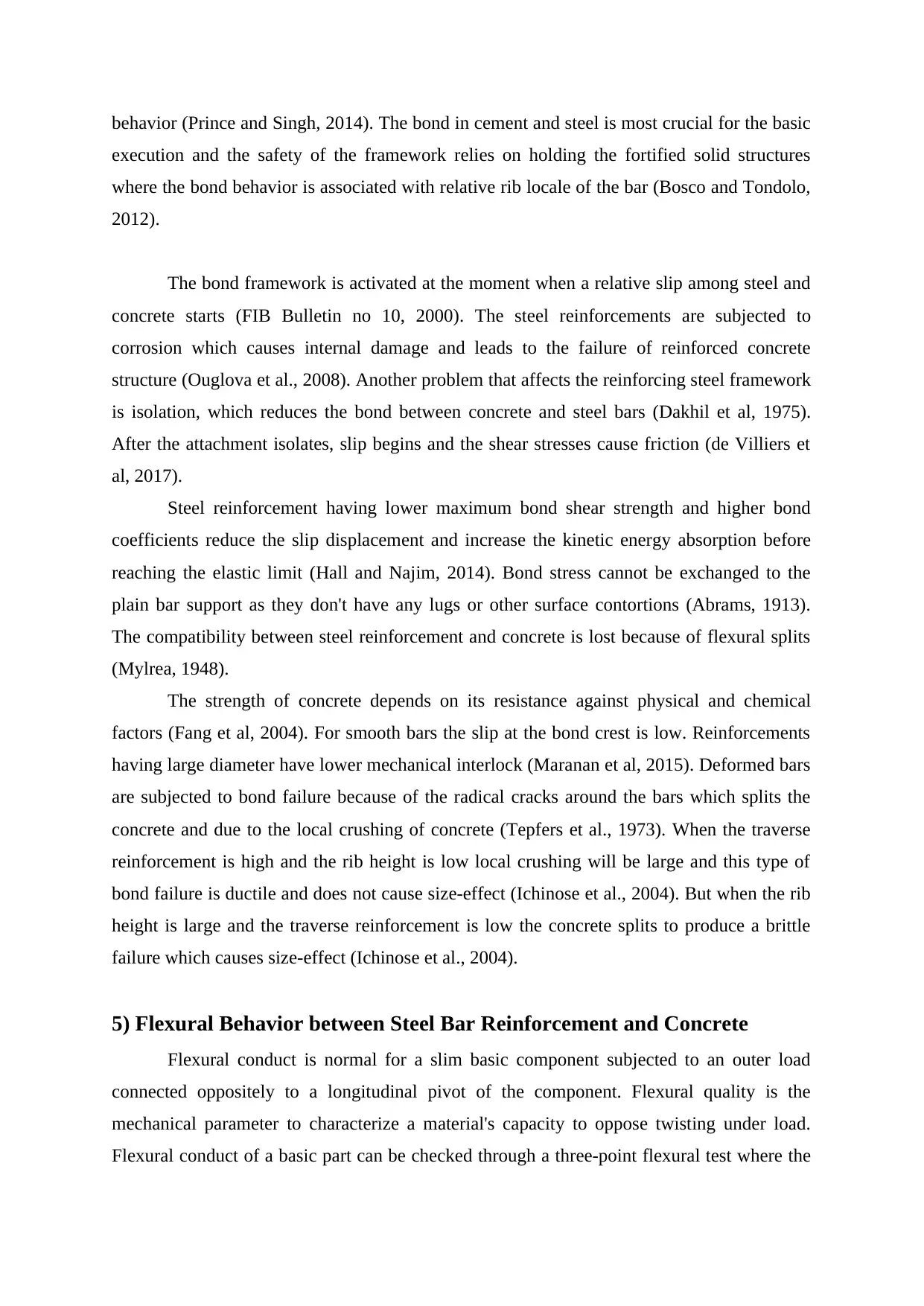
behavior (Prince and Singh, 2014). The bond in cement and steel is most crucial for the basic
execution and the safety of the framework relies on holding the fortified solid structures
where the bond behavior is associated with relative rib locale of the bar (Bosco and Tondolo,
2012).
The bond framework is activated at the moment when a relative slip among steel and
concrete starts (FIB Bulletin no 10, 2000). The steel reinforcements are subjected to
corrosion which causes internal damage and leads to the failure of reinforced concrete
structure (Ouglova et al., 2008). Another problem that affects the reinforcing steel framework
is isolation, which reduces the bond between concrete and steel bars (Dakhil et al, 1975).
After the attachment isolates, slip begins and the shear stresses cause friction (de Villiers et
al, 2017).
Steel reinforcement having lower maximum bond shear strength and higher bond
coefficients reduce the slip displacement and increase the kinetic energy absorption before
reaching the elastic limit (Hall and Najim, 2014). Bond stress cannot be exchanged to the
plain bar support as they don't have any lugs or other surface contortions (Abrams, 1913).
The compatibility between steel reinforcement and concrete is lost because of flexural splits
(Mylrea, 1948).
The strength of concrete depends on its resistance against physical and chemical
factors (Fang et al, 2004). For smooth bars the slip at the bond crest is low. Reinforcements
having large diameter have lower mechanical interlock (Maranan et al, 2015). Deformed bars
are subjected to bond failure because of the radical cracks around the bars which splits the
concrete and due to the local crushing of concrete (Tepfers et al., 1973). When the traverse
reinforcement is high and the rib height is low local crushing will be large and this type of
bond failure is ductile and does not cause size-effect (Ichinose et al., 2004). But when the rib
height is large and the traverse reinforcement is low the concrete splits to produce a brittle
failure which causes size-effect (Ichinose et al., 2004).
5) Flexural Behavior between Steel Bar Reinforcement and Concrete
Flexural conduct is normal for a slim basic component subjected to an outer load
connected oppositely to a longitudinal pivot of the component. Flexural quality is the
mechanical parameter to characterize a material's capacity to oppose twisting under load.
Flexural conduct of a basic part can be checked through a three-point flexural test where the
execution and the safety of the framework relies on holding the fortified solid structures
where the bond behavior is associated with relative rib locale of the bar (Bosco and Tondolo,
2012).
The bond framework is activated at the moment when a relative slip among steel and
concrete starts (FIB Bulletin no 10, 2000). The steel reinforcements are subjected to
corrosion which causes internal damage and leads to the failure of reinforced concrete
structure (Ouglova et al., 2008). Another problem that affects the reinforcing steel framework
is isolation, which reduces the bond between concrete and steel bars (Dakhil et al, 1975).
After the attachment isolates, slip begins and the shear stresses cause friction (de Villiers et
al, 2017).
Steel reinforcement having lower maximum bond shear strength and higher bond
coefficients reduce the slip displacement and increase the kinetic energy absorption before
reaching the elastic limit (Hall and Najim, 2014). Bond stress cannot be exchanged to the
plain bar support as they don't have any lugs or other surface contortions (Abrams, 1913).
The compatibility between steel reinforcement and concrete is lost because of flexural splits
(Mylrea, 1948).
The strength of concrete depends on its resistance against physical and chemical
factors (Fang et al, 2004). For smooth bars the slip at the bond crest is low. Reinforcements
having large diameter have lower mechanical interlock (Maranan et al, 2015). Deformed bars
are subjected to bond failure because of the radical cracks around the bars which splits the
concrete and due to the local crushing of concrete (Tepfers et al., 1973). When the traverse
reinforcement is high and the rib height is low local crushing will be large and this type of
bond failure is ductile and does not cause size-effect (Ichinose et al., 2004). But when the rib
height is large and the traverse reinforcement is low the concrete splits to produce a brittle
failure which causes size-effect (Ichinose et al., 2004).
5) Flexural Behavior between Steel Bar Reinforcement and Concrete
Flexural conduct is normal for a slim basic component subjected to an outer load
connected oppositely to a longitudinal pivot of the component. Flexural quality is the
mechanical parameter to characterize a material's capacity to oppose twisting under load.
Flexural conduct of a basic part can be checked through a three-point flexural test where the
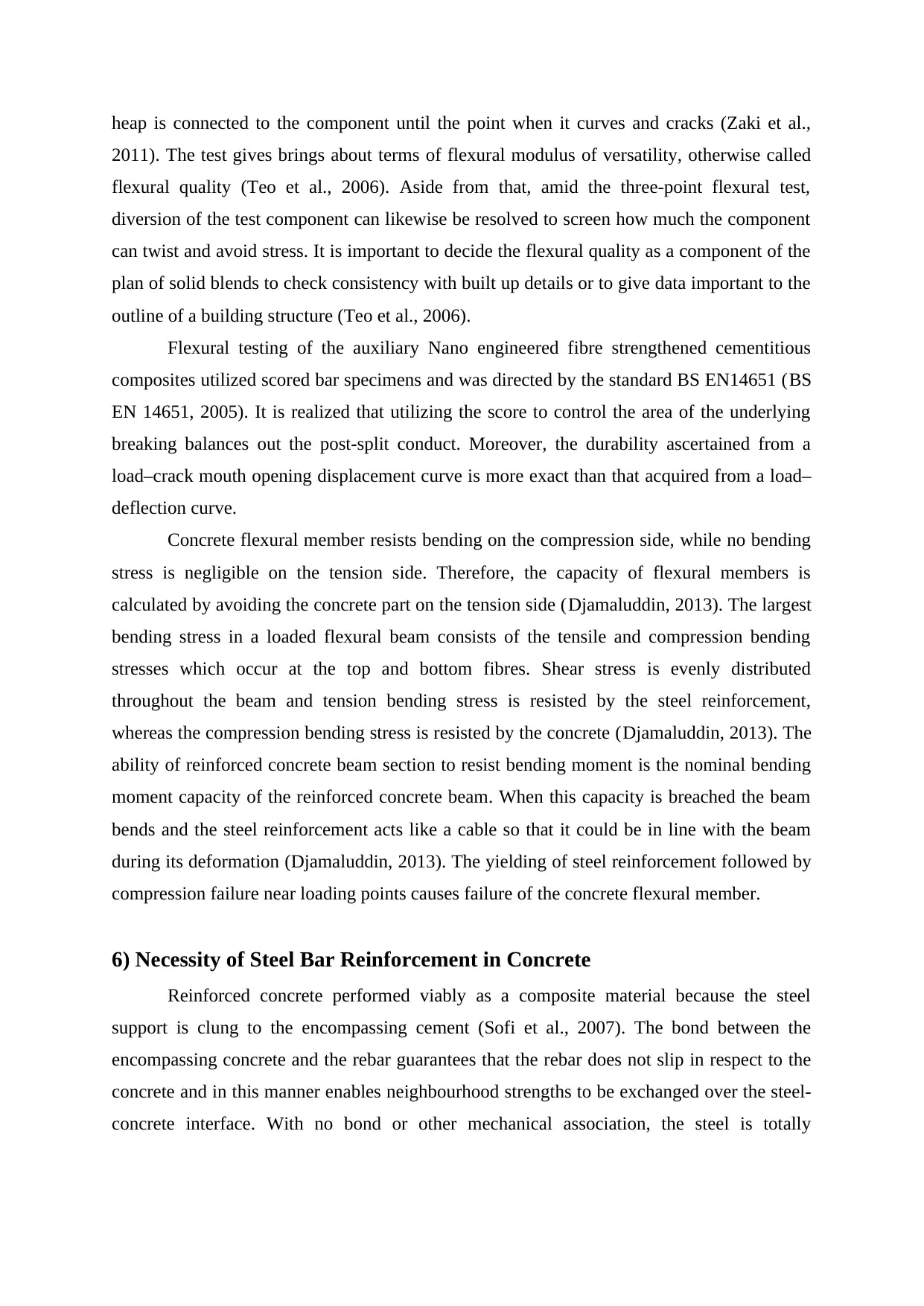
heap is connected to the component until the point when it curves and cracks (Zaki et al.,
2011). The test gives brings about terms of flexural modulus of versatility, otherwise called
flexural quality (Teo et al., 2006). Aside from that, amid the three-point flexural test,
diversion of the test component can likewise be resolved to screen how much the component
can twist and avoid stress. It is important to decide the flexural quality as a component of the
plan of solid blends to check consistency with built up details or to give data important to the
outline of a building structure (Teo et al., 2006).
Flexural testing of the auxiliary Nano engineered fibre strengthened cementitious
composites utilized scored bar specimens and was directed by the standard BS EN14651 (BS
EN 14651, 2005). It is realized that utilizing the score to control the area of the underlying
breaking balances out the post-split conduct. Moreover, the durability ascertained from a
load–crack mouth opening displacement curve is more exact than that acquired from a load–
deflection curve.
Concrete flexural member resists bending on the compression side, while no bending
stress is negligible on the tension side. Therefore, the capacity of flexural members is
calculated by avoiding the concrete part on the tension side (Djamaluddin, 2013). The largest
bending stress in a loaded flexural beam consists of the tensile and compression bending
stresses which occur at the top and bottom fibres. Shear stress is evenly distributed
throughout the beam and tension bending stress is resisted by the steel reinforcement,
whereas the compression bending stress is resisted by the concrete (Djamaluddin, 2013). The
ability of reinforced concrete beam section to resist bending moment is the nominal bending
moment capacity of the reinforced concrete beam. When this capacity is breached the beam
bends and the steel reinforcement acts like a cable so that it could be in line with the beam
during its deformation (Djamaluddin, 2013). The yielding of steel reinforcement followed by
compression failure near loading points causes failure of the concrete flexural member.
6) Necessity of Steel Bar Reinforcement in Concrete
Reinforced concrete performed viably as a composite material because the steel
support is clung to the encompassing cement (Sofi et al., 2007). The bond between the
encompassing concrete and the rebar guarantees that the rebar does not slip in respect to the
concrete and in this manner enables neighbourhood strengths to be exchanged over the steel-
concrete interface. With no bond or other mechanical association, the steel is totally
2011). The test gives brings about terms of flexural modulus of versatility, otherwise called
flexural quality (Teo et al., 2006). Aside from that, amid the three-point flexural test,
diversion of the test component can likewise be resolved to screen how much the component
can twist and avoid stress. It is important to decide the flexural quality as a component of the
plan of solid blends to check consistency with built up details or to give data important to the
outline of a building structure (Teo et al., 2006).
Flexural testing of the auxiliary Nano engineered fibre strengthened cementitious
composites utilized scored bar specimens and was directed by the standard BS EN14651 (BS
EN 14651, 2005). It is realized that utilizing the score to control the area of the underlying
breaking balances out the post-split conduct. Moreover, the durability ascertained from a
load–crack mouth opening displacement curve is more exact than that acquired from a load–
deflection curve.
Concrete flexural member resists bending on the compression side, while no bending
stress is negligible on the tension side. Therefore, the capacity of flexural members is
calculated by avoiding the concrete part on the tension side (Djamaluddin, 2013). The largest
bending stress in a loaded flexural beam consists of the tensile and compression bending
stresses which occur at the top and bottom fibres. Shear stress is evenly distributed
throughout the beam and tension bending stress is resisted by the steel reinforcement,
whereas the compression bending stress is resisted by the concrete (Djamaluddin, 2013). The
ability of reinforced concrete beam section to resist bending moment is the nominal bending
moment capacity of the reinforced concrete beam. When this capacity is breached the beam
bends and the steel reinforcement acts like a cable so that it could be in line with the beam
during its deformation (Djamaluddin, 2013). The yielding of steel reinforcement followed by
compression failure near loading points causes failure of the concrete flexural member.
6) Necessity of Steel Bar Reinforcement in Concrete
Reinforced concrete performed viably as a composite material because the steel
support is clung to the encompassing cement (Sofi et al., 2007). The bond between the
encompassing concrete and the rebar guarantees that the rebar does not slip in respect to the
concrete and in this manner enables neighbourhood strengths to be exchanged over the steel-
concrete interface. With no bond or other mechanical association, the steel is totally
⊘ This is a preview!⊘
Do you want full access?
Subscribe today to unlock all pages.

Trusted by 1+ million students worldwide
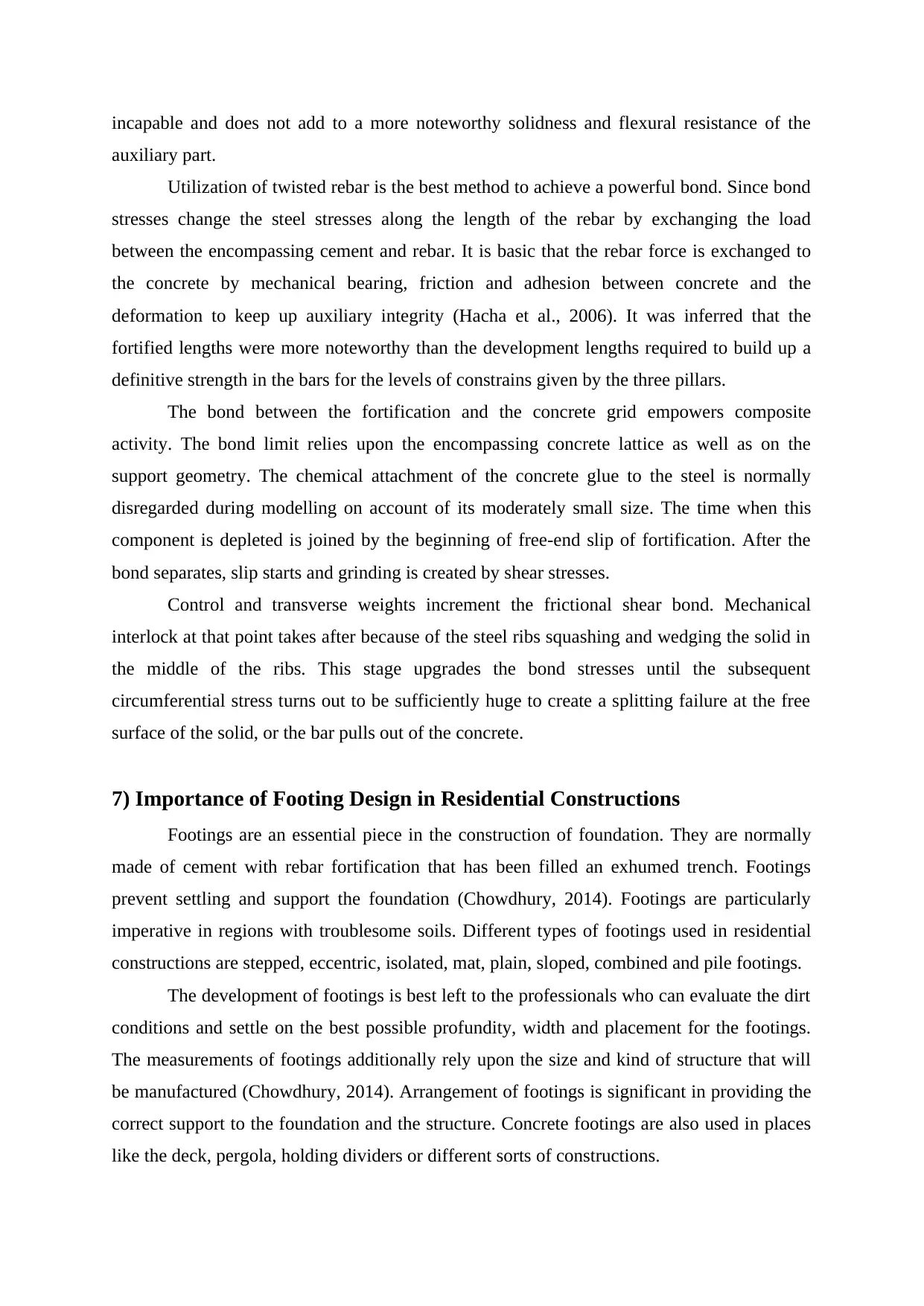
incapable and does not add to a more noteworthy solidness and flexural resistance of the
auxiliary part.
Utilization of twisted rebar is the best method to achieve a powerful bond. Since bond
stresses change the steel stresses along the length of the rebar by exchanging the load
between the encompassing cement and rebar. It is basic that the rebar force is exchanged to
the concrete by mechanical bearing, friction and adhesion between concrete and the
deformation to keep up auxiliary integrity (Hacha et al., 2006). It was inferred that the
fortified lengths were more noteworthy than the development lengths required to build up a
definitive strength in the bars for the levels of constrains given by the three pillars.
The bond between the fortification and the concrete grid empowers composite
activity. The bond limit relies upon the encompassing concrete lattice as well as on the
support geometry. The chemical attachment of the concrete glue to the steel is normally
disregarded during modelling on account of its moderately small size. The time when this
component is depleted is joined by the beginning of free-end slip of fortification. After the
bond separates, slip starts and grinding is created by shear stresses.
Control and transverse weights increment the frictional shear bond. Mechanical
interlock at that point takes after because of the steel ribs squashing and wedging the solid in
the middle of the ribs. This stage upgrades the bond stresses until the subsequent
circumferential stress turns out to be sufficiently huge to create a splitting failure at the free
surface of the solid, or the bar pulls out of the concrete.
7) Importance of Footing Design in Residential Constructions
Footings are an essential piece in the construction of foundation. They are normally
made of cement with rebar fortification that has been filled an exhumed trench. Footings
prevent settling and support the foundation (Chowdhury, 2014). Footings are particularly
imperative in regions with troublesome soils. Different types of footings used in residential
constructions are stepped, eccentric, isolated, mat, plain, sloped, combined and pile footings.
The development of footings is best left to the professionals who can evaluate the dirt
conditions and settle on the best possible profundity, width and placement for the footings.
The measurements of footings additionally rely upon the size and kind of structure that will
be manufactured (Chowdhury, 2014). Arrangement of footings is significant in providing the
correct support to the foundation and the structure. Concrete footings are also used in places
like the deck, pergola, holding dividers or different sorts of constructions.
auxiliary part.
Utilization of twisted rebar is the best method to achieve a powerful bond. Since bond
stresses change the steel stresses along the length of the rebar by exchanging the load
between the encompassing cement and rebar. It is basic that the rebar force is exchanged to
the concrete by mechanical bearing, friction and adhesion between concrete and the
deformation to keep up auxiliary integrity (Hacha et al., 2006). It was inferred that the
fortified lengths were more noteworthy than the development lengths required to build up a
definitive strength in the bars for the levels of constrains given by the three pillars.
The bond between the fortification and the concrete grid empowers composite
activity. The bond limit relies upon the encompassing concrete lattice as well as on the
support geometry. The chemical attachment of the concrete glue to the steel is normally
disregarded during modelling on account of its moderately small size. The time when this
component is depleted is joined by the beginning of free-end slip of fortification. After the
bond separates, slip starts and grinding is created by shear stresses.
Control and transverse weights increment the frictional shear bond. Mechanical
interlock at that point takes after because of the steel ribs squashing and wedging the solid in
the middle of the ribs. This stage upgrades the bond stresses until the subsequent
circumferential stress turns out to be sufficiently huge to create a splitting failure at the free
surface of the solid, or the bar pulls out of the concrete.
7) Importance of Footing Design in Residential Constructions
Footings are an essential piece in the construction of foundation. They are normally
made of cement with rebar fortification that has been filled an exhumed trench. Footings
prevent settling and support the foundation (Chowdhury, 2014). Footings are particularly
imperative in regions with troublesome soils. Different types of footings used in residential
constructions are stepped, eccentric, isolated, mat, plain, sloped, combined and pile footings.
The development of footings is best left to the professionals who can evaluate the dirt
conditions and settle on the best possible profundity, width and placement for the footings.
The measurements of footings additionally rely upon the size and kind of structure that will
be manufactured (Chowdhury, 2014). Arrangement of footings is significant in providing the
correct support to the foundation and the structure. Concrete footings are also used in places
like the deck, pergola, holding dividers or different sorts of constructions.
Paraphrase This Document
Need a fresh take? Get an instant paraphrase of this document with our AI Paraphraser
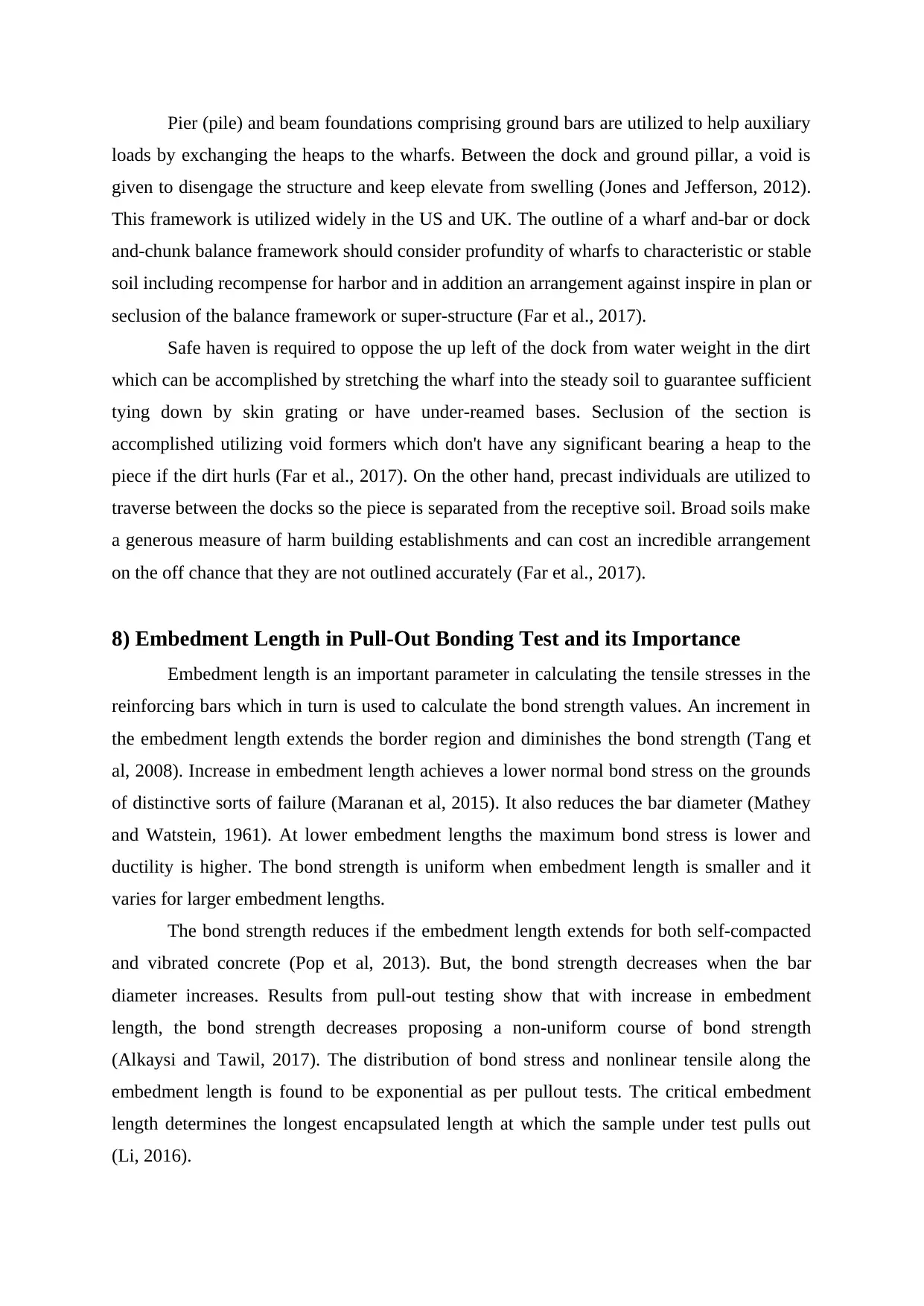
Pier (pile) and beam foundations comprising ground bars are utilized to help auxiliary
loads by exchanging the heaps to the wharfs. Between the dock and ground pillar, a void is
given to disengage the structure and keep elevate from swelling (Jones and Jefferson, 2012).
This framework is utilized widely in the US and UK. The outline of a wharf and-bar or dock
and-chunk balance framework should consider profundity of wharfs to characteristic or stable
soil including recompense for harbor and in addition an arrangement against inspire in plan or
seclusion of the balance framework or super-structure (Far et al., 2017).
Safe haven is required to oppose the up left of the dock from water weight in the dirt
which can be accomplished by stretching the wharf into the steady soil to guarantee sufficient
tying down by skin grating or have under-reamed bases. Seclusion of the section is
accomplished utilizing void formers which don't have any significant bearing a heap to the
piece if the dirt hurls (Far et al., 2017). On the other hand, precast individuals are utilized to
traverse between the docks so the piece is separated from the receptive soil. Broad soils make
a generous measure of harm building establishments and can cost an incredible arrangement
on the off chance that they are not outlined accurately (Far et al., 2017).
8) Embedment Length in Pull-Out Bonding Test and its Importance
Embedment length is an important parameter in calculating the tensile stresses in the
reinforcing bars which in turn is used to calculate the bond strength values. An increment in
the embedment length extends the border region and diminishes the bond strength (Tang et
al, 2008). Increase in embedment length achieves a lower normal bond stress on the grounds
of distinctive sorts of failure (Maranan et al, 2015). It also reduces the bar diameter (Mathey
and Watstein, 1961). At lower embedment lengths the maximum bond stress is lower and
ductility is higher. The bond strength is uniform when embedment length is smaller and it
varies for larger embedment lengths.
The bond strength reduces if the embedment length extends for both self-compacted
and vibrated concrete (Pop et al, 2013). But, the bond strength decreases when the bar
diameter increases. Results from pull-out testing show that with increase in embedment
length, the bond strength decreases proposing a non-uniform course of bond strength
(Alkaysi and Tawil, 2017). The distribution of bond stress and nonlinear tensile along the
embedment length is found to be exponential as per pullout tests. The critical embedment
length determines the longest encapsulated length at which the sample under test pulls out
(Li, 2016).
loads by exchanging the heaps to the wharfs. Between the dock and ground pillar, a void is
given to disengage the structure and keep elevate from swelling (Jones and Jefferson, 2012).
This framework is utilized widely in the US and UK. The outline of a wharf and-bar or dock
and-chunk balance framework should consider profundity of wharfs to characteristic or stable
soil including recompense for harbor and in addition an arrangement against inspire in plan or
seclusion of the balance framework or super-structure (Far et al., 2017).
Safe haven is required to oppose the up left of the dock from water weight in the dirt
which can be accomplished by stretching the wharf into the steady soil to guarantee sufficient
tying down by skin grating or have under-reamed bases. Seclusion of the section is
accomplished utilizing void formers which don't have any significant bearing a heap to the
piece if the dirt hurls (Far et al., 2017). On the other hand, precast individuals are utilized to
traverse between the docks so the piece is separated from the receptive soil. Broad soils make
a generous measure of harm building establishments and can cost an incredible arrangement
on the off chance that they are not outlined accurately (Far et al., 2017).
8) Embedment Length in Pull-Out Bonding Test and its Importance
Embedment length is an important parameter in calculating the tensile stresses in the
reinforcing bars which in turn is used to calculate the bond strength values. An increment in
the embedment length extends the border region and diminishes the bond strength (Tang et
al, 2008). Increase in embedment length achieves a lower normal bond stress on the grounds
of distinctive sorts of failure (Maranan et al, 2015). It also reduces the bar diameter (Mathey
and Watstein, 1961). At lower embedment lengths the maximum bond stress is lower and
ductility is higher. The bond strength is uniform when embedment length is smaller and it
varies for larger embedment lengths.
The bond strength reduces if the embedment length extends for both self-compacted
and vibrated concrete (Pop et al, 2013). But, the bond strength decreases when the bar
diameter increases. Results from pull-out testing show that with increase in embedment
length, the bond strength decreases proposing a non-uniform course of bond strength
(Alkaysi and Tawil, 2017). The distribution of bond stress and nonlinear tensile along the
embedment length is found to be exponential as per pullout tests. The critical embedment
length determines the longest encapsulated length at which the sample under test pulls out
(Li, 2016).
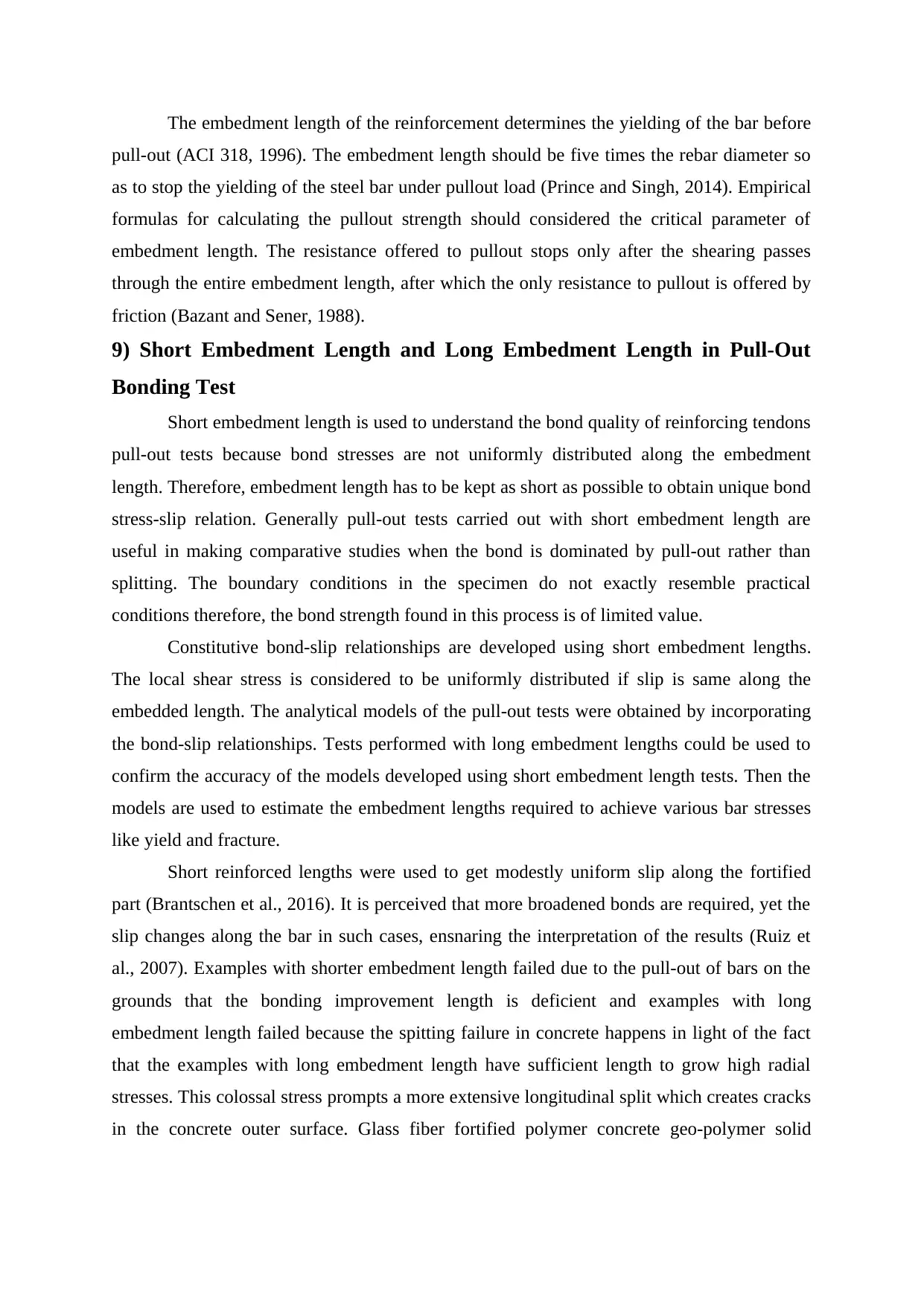
The embedment length of the reinforcement determines the yielding of the bar before
pull-out (ACI 318, 1996). The embedment length should be five times the rebar diameter so
as to stop the yielding of the steel bar under pullout load (Prince and Singh, 2014). Empirical
formulas for calculating the pullout strength should considered the critical parameter of
embedment length. The resistance offered to pullout stops only after the shearing passes
through the entire embedment length, after which the only resistance to pullout is offered by
friction (Bazant and Sener, 1988).
9) Short Embedment Length and Long Embedment Length in Pull-Out
Bonding Test
Short embedment length is used to understand the bond quality of reinforcing tendons
pull-out tests because bond stresses are not uniformly distributed along the embedment
length. Therefore, embedment length has to be kept as short as possible to obtain unique bond
stress-slip relation. Generally pull-out tests carried out with short embedment length are
useful in making comparative studies when the bond is dominated by pull-out rather than
splitting. The boundary conditions in the specimen do not exactly resemble practical
conditions therefore, the bond strength found in this process is of limited value.
Constitutive bond-slip relationships are developed using short embedment lengths.
The local shear stress is considered to be uniformly distributed if slip is same along the
embedded length. The analytical models of the pull-out tests were obtained by incorporating
the bond-slip relationships. Tests performed with long embedment lengths could be used to
confirm the accuracy of the models developed using short embedment length tests. Then the
models are used to estimate the embedment lengths required to achieve various bar stresses
like yield and fracture.
Short reinforced lengths were used to get modestly uniform slip along the fortified
part (Brantschen et al., 2016). It is perceived that more broadened bonds are required, yet the
slip changes along the bar in such cases, ensnaring the interpretation of the results (Ruiz et
al., 2007). Examples with shorter embedment length failed due to the pull-out of bars on the
grounds that the bonding improvement length is deficient and examples with long
embedment length failed because the spitting failure in concrete happens in light of the fact
that the examples with long embedment length have sufficient length to grow high radial
stresses. This colossal stress prompts a more extensive longitudinal split which creates cracks
in the concrete outer surface. Glass fiber fortified polymer concrete geo-polymer solid
pull-out (ACI 318, 1996). The embedment length should be five times the rebar diameter so
as to stop the yielding of the steel bar under pullout load (Prince and Singh, 2014). Empirical
formulas for calculating the pullout strength should considered the critical parameter of
embedment length. The resistance offered to pullout stops only after the shearing passes
through the entire embedment length, after which the only resistance to pullout is offered by
friction (Bazant and Sener, 1988).
9) Short Embedment Length and Long Embedment Length in Pull-Out
Bonding Test
Short embedment length is used to understand the bond quality of reinforcing tendons
pull-out tests because bond stresses are not uniformly distributed along the embedment
length. Therefore, embedment length has to be kept as short as possible to obtain unique bond
stress-slip relation. Generally pull-out tests carried out with short embedment length are
useful in making comparative studies when the bond is dominated by pull-out rather than
splitting. The boundary conditions in the specimen do not exactly resemble practical
conditions therefore, the bond strength found in this process is of limited value.
Constitutive bond-slip relationships are developed using short embedment lengths.
The local shear stress is considered to be uniformly distributed if slip is same along the
embedded length. The analytical models of the pull-out tests were obtained by incorporating
the bond-slip relationships. Tests performed with long embedment lengths could be used to
confirm the accuracy of the models developed using short embedment length tests. Then the
models are used to estimate the embedment lengths required to achieve various bar stresses
like yield and fracture.
Short reinforced lengths were used to get modestly uniform slip along the fortified
part (Brantschen et al., 2016). It is perceived that more broadened bonds are required, yet the
slip changes along the bar in such cases, ensnaring the interpretation of the results (Ruiz et
al., 2007). Examples with shorter embedment length failed due to the pull-out of bars on the
grounds that the bonding improvement length is deficient and examples with long
embedment length failed because the spitting failure in concrete happens in light of the fact
that the examples with long embedment length have sufficient length to grow high radial
stresses. This colossal stress prompts a more extensive longitudinal split which creates cracks
in the concrete outer surface. Glass fiber fortified polymer concrete geo-polymer solid
⊘ This is a preview!⊘
Do you want full access?
Subscribe today to unlock all pages.

Trusted by 1+ million students worldwide
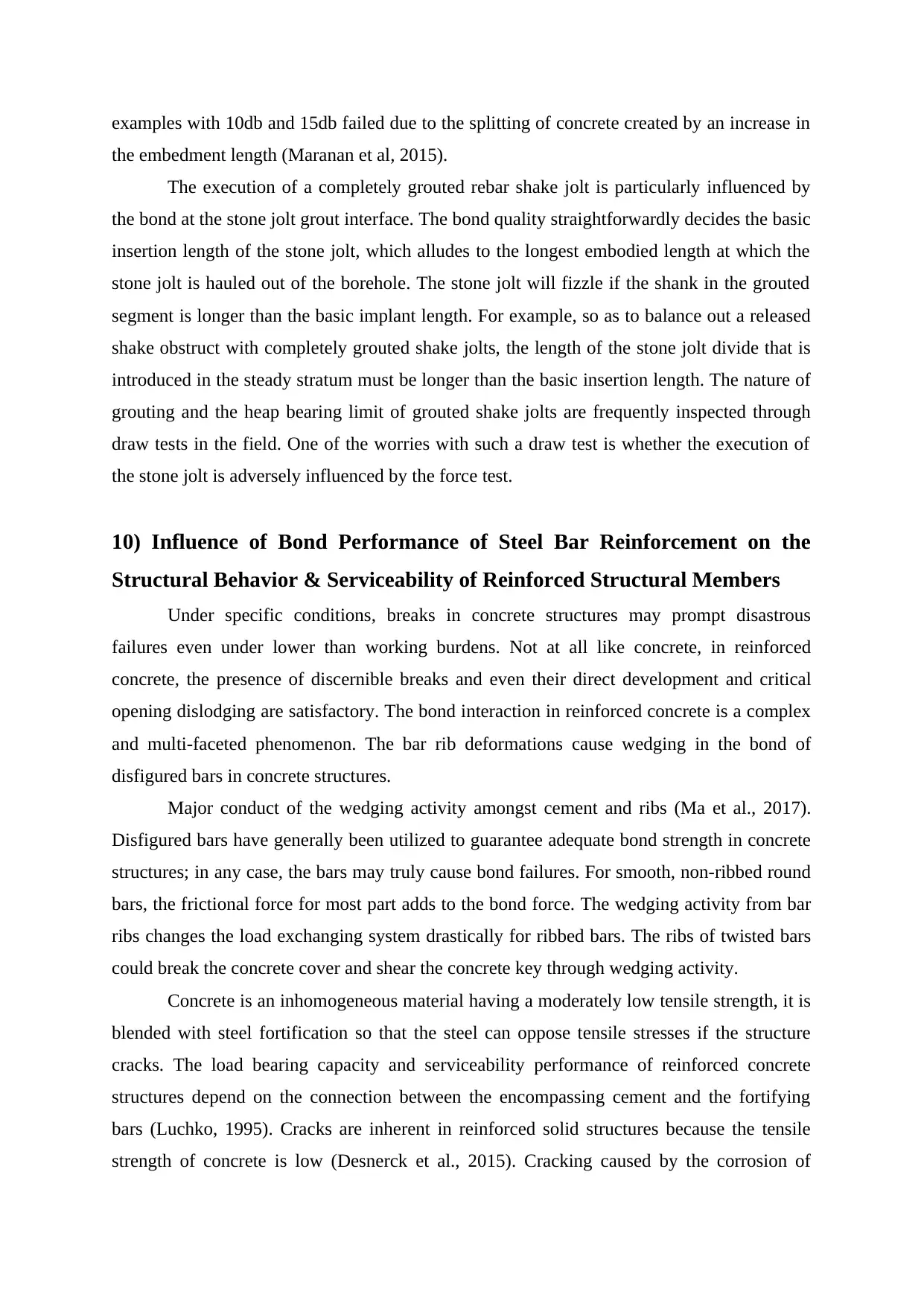
examples with 10db and 15db failed due to the splitting of concrete created by an increase in
the embedment length (Maranan et al, 2015).
The execution of a completely grouted rebar shake jolt is particularly influenced by
the bond at the stone jolt grout interface. The bond quality straightforwardly decides the basic
insertion length of the stone jolt, which alludes to the longest embodied length at which the
stone jolt is hauled out of the borehole. The stone jolt will fizzle if the shank in the grouted
segment is longer than the basic implant length. For example, so as to balance out a released
shake obstruct with completely grouted shake jolts, the length of the stone jolt divide that is
introduced in the steady stratum must be longer than the basic insertion length. The nature of
grouting and the heap bearing limit of grouted shake jolts are frequently inspected through
draw tests in the field. One of the worries with such a draw test is whether the execution of
the stone jolt is adversely influenced by the force test.
10) Influence of Bond Performance of Steel Bar Reinforcement on the
Structural Behavior & Serviceability of Reinforced Structural Members
Under specific conditions, breaks in concrete structures may prompt disastrous
failures even under lower than working burdens. Not at all like concrete, in reinforced
concrete, the presence of discernible breaks and even their direct development and critical
opening dislodging are satisfactory. The bond interaction in reinforced concrete is a complex
and multi-faceted phenomenon. The bar rib deformations cause wedging in the bond of
disfigured bars in concrete structures.
Major conduct of the wedging activity amongst cement and ribs (Ma et al., 2017).
Disfigured bars have generally been utilized to guarantee adequate bond strength in concrete
structures; in any case, the bars may truly cause bond failures. For smooth, non-ribbed round
bars, the frictional force for most part adds to the bond force. The wedging activity from bar
ribs changes the load exchanging system drastically for ribbed bars. The ribs of twisted bars
could break the concrete cover and shear the concrete key through wedging activity.
Concrete is an inhomogeneous material having a moderately low tensile strength, it is
blended with steel fortification so that the steel can oppose tensile stresses if the structure
cracks. The load bearing capacity and serviceability performance of reinforced concrete
structures depend on the connection between the encompassing cement and the fortifying
bars (Luchko, 1995). Cracks are inherent in reinforced solid structures because the tensile
strength of concrete is low (Desnerck et al., 2015). Cracking caused by the corrosion of
the embedment length (Maranan et al, 2015).
The execution of a completely grouted rebar shake jolt is particularly influenced by
the bond at the stone jolt grout interface. The bond quality straightforwardly decides the basic
insertion length of the stone jolt, which alludes to the longest embodied length at which the
stone jolt is hauled out of the borehole. The stone jolt will fizzle if the shank in the grouted
segment is longer than the basic implant length. For example, so as to balance out a released
shake obstruct with completely grouted shake jolts, the length of the stone jolt divide that is
introduced in the steady stratum must be longer than the basic insertion length. The nature of
grouting and the heap bearing limit of grouted shake jolts are frequently inspected through
draw tests in the field. One of the worries with such a draw test is whether the execution of
the stone jolt is adversely influenced by the force test.
10) Influence of Bond Performance of Steel Bar Reinforcement on the
Structural Behavior & Serviceability of Reinforced Structural Members
Under specific conditions, breaks in concrete structures may prompt disastrous
failures even under lower than working burdens. Not at all like concrete, in reinforced
concrete, the presence of discernible breaks and even their direct development and critical
opening dislodging are satisfactory. The bond interaction in reinforced concrete is a complex
and multi-faceted phenomenon. The bar rib deformations cause wedging in the bond of
disfigured bars in concrete structures.
Major conduct of the wedging activity amongst cement and ribs (Ma et al., 2017).
Disfigured bars have generally been utilized to guarantee adequate bond strength in concrete
structures; in any case, the bars may truly cause bond failures. For smooth, non-ribbed round
bars, the frictional force for most part adds to the bond force. The wedging activity from bar
ribs changes the load exchanging system drastically for ribbed bars. The ribs of twisted bars
could break the concrete cover and shear the concrete key through wedging activity.
Concrete is an inhomogeneous material having a moderately low tensile strength, it is
blended with steel fortification so that the steel can oppose tensile stresses if the structure
cracks. The load bearing capacity and serviceability performance of reinforced concrete
structures depend on the connection between the encompassing cement and the fortifying
bars (Luchko, 1995). Cracks are inherent in reinforced solid structures because the tensile
strength of concrete is low (Desnerck et al., 2015). Cracking caused by the corrosion of
Paraphrase This Document
Need a fresh take? Get an instant paraphrase of this document with our AI Paraphraser
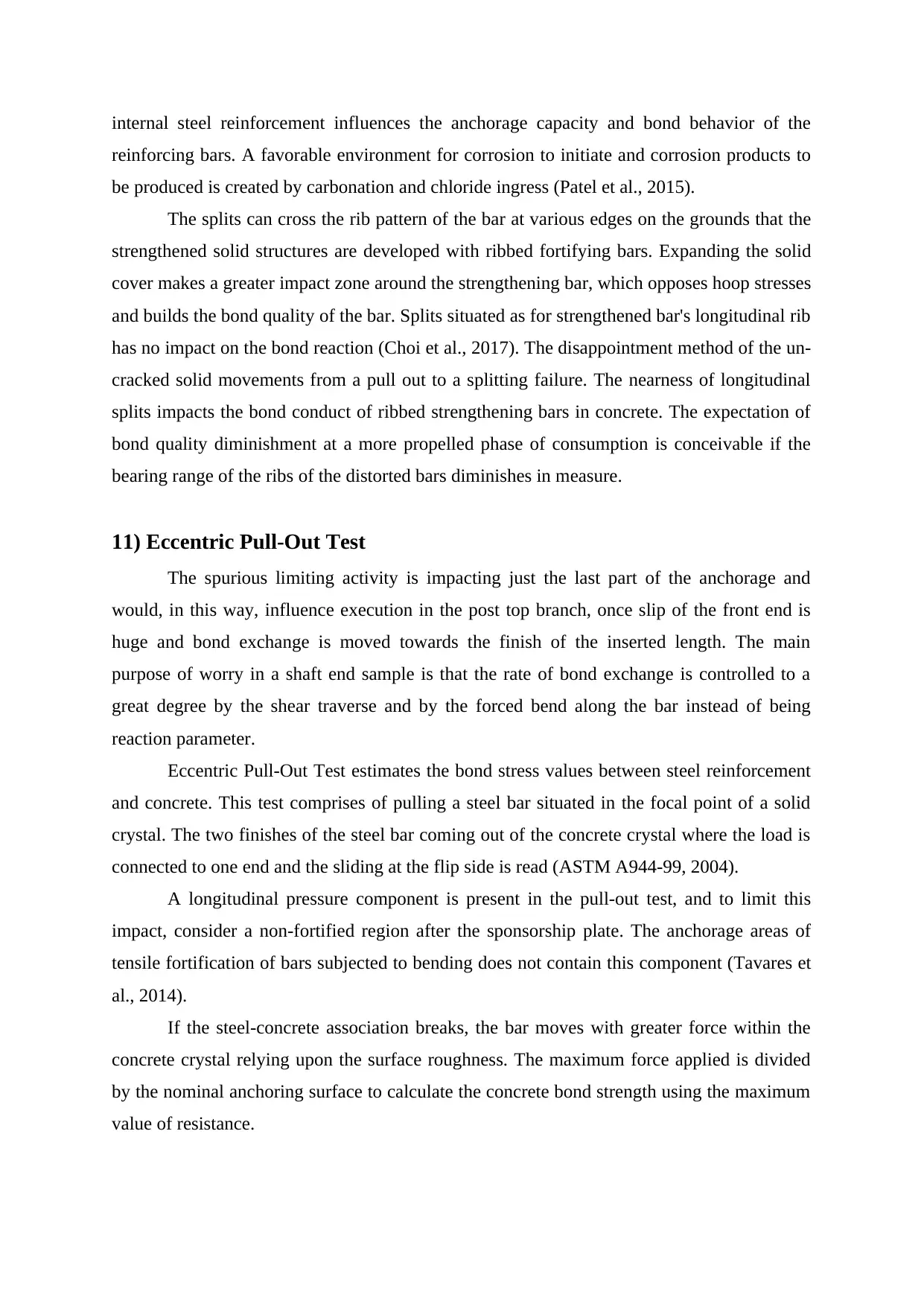
internal steel reinforcement influences the anchorage capacity and bond behavior of the
reinforcing bars. A favorable environment for corrosion to initiate and corrosion products to
be produced is created by carbonation and chloride ingress (Patel et al., 2015).
The splits can cross the rib pattern of the bar at various edges on the grounds that the
strengthened solid structures are developed with ribbed fortifying bars. Expanding the solid
cover makes a greater impact zone around the strengthening bar, which opposes hoop stresses
and builds the bond quality of the bar. Splits situated as for strengthened bar's longitudinal rib
has no impact on the bond reaction (Choi et al., 2017). The disappointment method of the un-
cracked solid movements from a pull out to a splitting failure. The nearness of longitudinal
splits impacts the bond conduct of ribbed strengthening bars in concrete. The expectation of
bond quality diminishment at a more propelled phase of consumption is conceivable if the
bearing range of the ribs of the distorted bars diminishes in measure.
11) Eccentric Pull-Out Test
The spurious limiting activity is impacting just the last part of the anchorage and
would, in this way, influence execution in the post top branch, once slip of the front end is
huge and bond exchange is moved towards the finish of the inserted length. The main
purpose of worry in a shaft end sample is that the rate of bond exchange is controlled to a
great degree by the shear traverse and by the forced bend along the bar instead of being
reaction parameter.
Eccentric Pull-Out Test estimates the bond stress values between steel reinforcement
and concrete. This test comprises of pulling a steel bar situated in the focal point of a solid
crystal. The two finishes of the steel bar coming out of the concrete crystal where the load is
connected to one end and the sliding at the flip side is read (ASTM A944-99, 2004).
A longitudinal pressure component is present in the pull-out test, and to limit this
impact, consider a non-fortified region after the sponsorship plate. The anchorage areas of
tensile fortification of bars subjected to bending does not contain this component (Tavares et
al., 2014).
If the steel-concrete association breaks, the bar moves with greater force within the
concrete crystal relying upon the surface roughness. The maximum force applied is divided
by the nominal anchoring surface to calculate the concrete bond strength using the maximum
value of resistance.
reinforcing bars. A favorable environment for corrosion to initiate and corrosion products to
be produced is created by carbonation and chloride ingress (Patel et al., 2015).
The splits can cross the rib pattern of the bar at various edges on the grounds that the
strengthened solid structures are developed with ribbed fortifying bars. Expanding the solid
cover makes a greater impact zone around the strengthening bar, which opposes hoop stresses
and builds the bond quality of the bar. Splits situated as for strengthened bar's longitudinal rib
has no impact on the bond reaction (Choi et al., 2017). The disappointment method of the un-
cracked solid movements from a pull out to a splitting failure. The nearness of longitudinal
splits impacts the bond conduct of ribbed strengthening bars in concrete. The expectation of
bond quality diminishment at a more propelled phase of consumption is conceivable if the
bearing range of the ribs of the distorted bars diminishes in measure.
11) Eccentric Pull-Out Test
The spurious limiting activity is impacting just the last part of the anchorage and
would, in this way, influence execution in the post top branch, once slip of the front end is
huge and bond exchange is moved towards the finish of the inserted length. The main
purpose of worry in a shaft end sample is that the rate of bond exchange is controlled to a
great degree by the shear traverse and by the forced bend along the bar instead of being
reaction parameter.
Eccentric Pull-Out Test estimates the bond stress values between steel reinforcement
and concrete. This test comprises of pulling a steel bar situated in the focal point of a solid
crystal. The two finishes of the steel bar coming out of the concrete crystal where the load is
connected to one end and the sliding at the flip side is read (ASTM A944-99, 2004).
A longitudinal pressure component is present in the pull-out test, and to limit this
impact, consider a non-fortified region after the sponsorship plate. The anchorage areas of
tensile fortification of bars subjected to bending does not contain this component (Tavares et
al., 2014).
If the steel-concrete association breaks, the bar moves with greater force within the
concrete crystal relying upon the surface roughness. The maximum force applied is divided
by the nominal anchoring surface to calculate the concrete bond strength using the maximum
value of resistance.
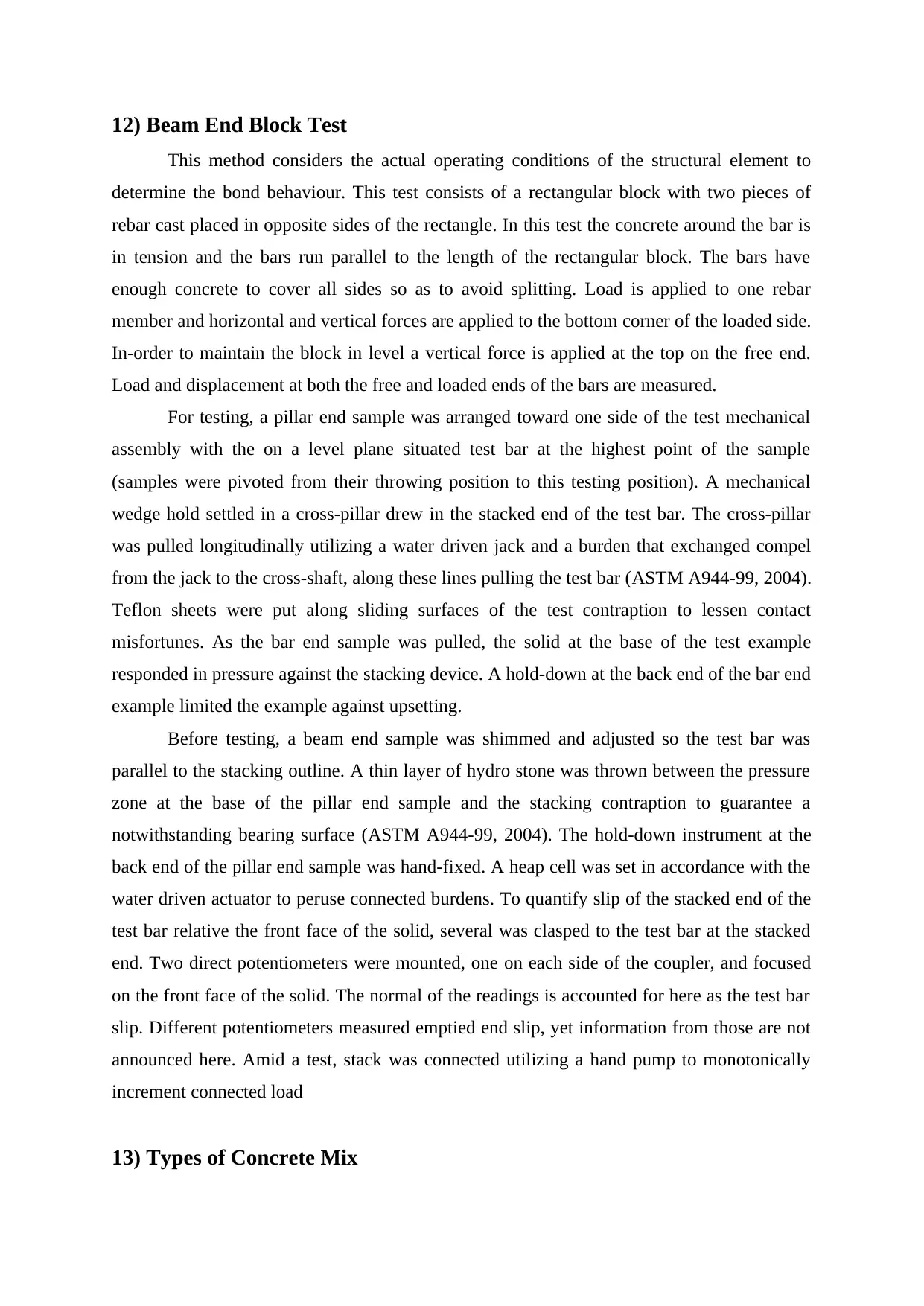
12) Beam End Block Test
This method considers the actual operating conditions of the structural element to
determine the bond behaviour. This test consists of a rectangular block with two pieces of
rebar cast placed in opposite sides of the rectangle. In this test the concrete around the bar is
in tension and the bars run parallel to the length of the rectangular block. The bars have
enough concrete to cover all sides so as to avoid splitting. Load is applied to one rebar
member and horizontal and vertical forces are applied to the bottom corner of the loaded side.
In-order to maintain the block in level a vertical force is applied at the top on the free end.
Load and displacement at both the free and loaded ends of the bars are measured.
For testing, a pillar end sample was arranged toward one side of the test mechanical
assembly with the on a level plane situated test bar at the highest point of the sample
(samples were pivoted from their throwing position to this testing position). A mechanical
wedge hold settled in a cross-pillar drew in the stacked end of the test bar. The cross-pillar
was pulled longitudinally utilizing a water driven jack and a burden that exchanged compel
from the jack to the cross-shaft, along these lines pulling the test bar (ASTM A944-99, 2004).
Teflon sheets were put along sliding surfaces of the test contraption to lessen contact
misfortunes. As the bar end sample was pulled, the solid at the base of the test example
responded in pressure against the stacking device. A hold-down at the back end of the bar end
example limited the example against upsetting.
Before testing, a beam end sample was shimmed and adjusted so the test bar was
parallel to the stacking outline. A thin layer of hydro stone was thrown between the pressure
zone at the base of the pillar end sample and the stacking contraption to guarantee a
notwithstanding bearing surface (ASTM A944-99, 2004). The hold-down instrument at the
back end of the pillar end sample was hand-fixed. A heap cell was set in accordance with the
water driven actuator to peruse connected burdens. To quantify slip of the stacked end of the
test bar relative the front face of the solid, several was clasped to the test bar at the stacked
end. Two direct potentiometers were mounted, one on each side of the coupler, and focused
on the front face of the solid. The normal of the readings is accounted for here as the test bar
slip. Different potentiometers measured emptied end slip, yet information from those are not
announced here. Amid a test, stack was connected utilizing a hand pump to monotonically
increment connected load
13) Types of Concrete Mix
This method considers the actual operating conditions of the structural element to
determine the bond behaviour. This test consists of a rectangular block with two pieces of
rebar cast placed in opposite sides of the rectangle. In this test the concrete around the bar is
in tension and the bars run parallel to the length of the rectangular block. The bars have
enough concrete to cover all sides so as to avoid splitting. Load is applied to one rebar
member and horizontal and vertical forces are applied to the bottom corner of the loaded side.
In-order to maintain the block in level a vertical force is applied at the top on the free end.
Load and displacement at both the free and loaded ends of the bars are measured.
For testing, a pillar end sample was arranged toward one side of the test mechanical
assembly with the on a level plane situated test bar at the highest point of the sample
(samples were pivoted from their throwing position to this testing position). A mechanical
wedge hold settled in a cross-pillar drew in the stacked end of the test bar. The cross-pillar
was pulled longitudinally utilizing a water driven jack and a burden that exchanged compel
from the jack to the cross-shaft, along these lines pulling the test bar (ASTM A944-99, 2004).
Teflon sheets were put along sliding surfaces of the test contraption to lessen contact
misfortunes. As the bar end sample was pulled, the solid at the base of the test example
responded in pressure against the stacking device. A hold-down at the back end of the bar end
example limited the example against upsetting.
Before testing, a beam end sample was shimmed and adjusted so the test bar was
parallel to the stacking outline. A thin layer of hydro stone was thrown between the pressure
zone at the base of the pillar end sample and the stacking contraption to guarantee a
notwithstanding bearing surface (ASTM A944-99, 2004). The hold-down instrument at the
back end of the pillar end sample was hand-fixed. A heap cell was set in accordance with the
water driven actuator to peruse connected burdens. To quantify slip of the stacked end of the
test bar relative the front face of the solid, several was clasped to the test bar at the stacked
end. Two direct potentiometers were mounted, one on each side of the coupler, and focused
on the front face of the solid. The normal of the readings is accounted for here as the test bar
slip. Different potentiometers measured emptied end slip, yet information from those are not
announced here. Amid a test, stack was connected utilizing a hand pump to monotonically
increment connected load
13) Types of Concrete Mix
⊘ This is a preview!⊘
Do you want full access?
Subscribe today to unlock all pages.

Trusted by 1+ million students worldwide
1 out of 22
Related Documents
Your All-in-One AI-Powered Toolkit for Academic Success.
+13062052269
info@desklib.com
Available 24*7 on WhatsApp / Email
![[object Object]](/_next/static/media/star-bottom.7253800d.svg)
Unlock your academic potential
Copyright © 2020–2025 A2Z Services. All Rights Reserved. Developed and managed by ZUCOL.



